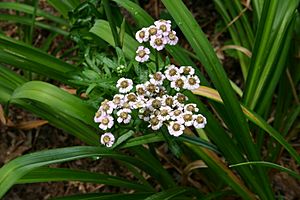Alpine yarrow facts for kids
Quick facts for kids Alpine yarrow |
|
|---|---|
 |
|
| Scientific classification | |
| Genus: |
Achillea
|
| Species: |
alpina
|
| Synonyms | |
|
Synonymy
Achillea angustifolia Salisb.
Achillea bocconii W.D.J.Koch Achillea cristata Willd. Achillea denticulata Besser ex Heimerl Achillea depressa Fisch. ex Herder Achillea mongolica Fisch. ex Spreng. Achillea multiflora Hook. Achillea punctata Moench Achillea ramosissima Moench Achillea sibirica Ledeb. Achillea squarrosa Hassk. Achillea subcartilaginea (Heimerl) Heimerl Ptarmica mongolica (Fisch. ex Spreng.) DC. Ptarmica sibirica Ledeb. |
|
Achillea alpina, also known as alpine yarrow or Siberian yarrow, is a type of flowering plant. It belongs to the sunflower family. This plant grows naturally in parts of Asia and North America. You can find it in places like Siberia, China, Japan, Canada, and the northern United States.
About the Alpine Yarrow
The alpine yarrow is a perennial herb. This means it lives for more than two years. It can grow up to 80 centimeters (about 2.5 feet) tall. Its flowers are usually white, but sometimes they can be a light purple color.
The flowers have two main parts. There are ray florets, which look like petals around the edge. And there are disc florets, which are tiny flowers in the center. The leaves of the plant are narrow and grow close together.
Where it Grows
This plant likes to grow in thick bushes and along shorelines. In northwestern North America, it is often found near water. You can also see it in open woods, along stream banks, and next to roads.
In northern Minnesota, some groups of this plant grow in wet, grassy areas called peat meadows. These meadows are often found near aspen trees. Because it is rare in Minnesota, the alpine yarrow was listed as a special plant to protect in 1996.
See also
 In Spanish: Achillea alpina para niños
In Spanish: Achillea alpina para niños

